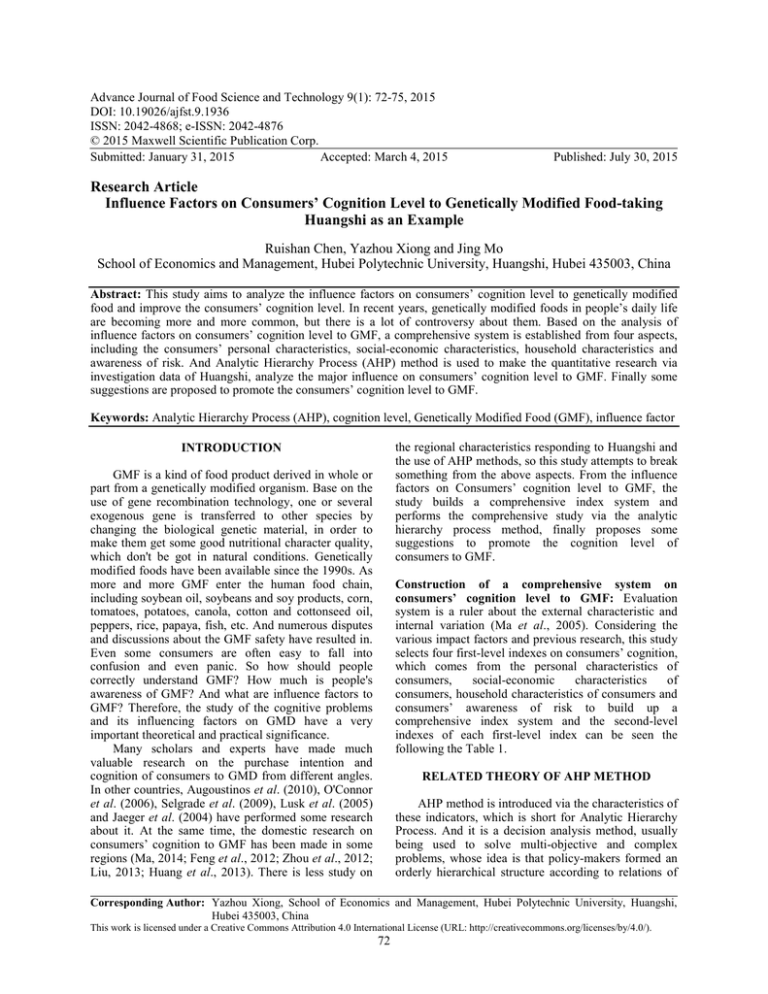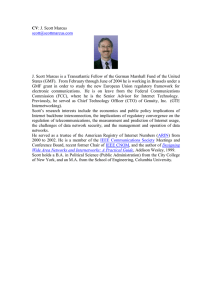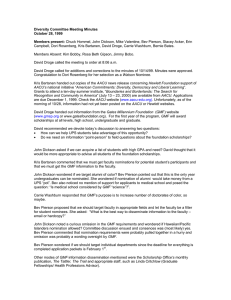Advance Journal of Food Science and Technology 9(1): 72-75, 2015
advertisement

Advance Journal of Food Science and Technology 9(1): 72-75, 2015 DOI: 10.19026/ajfst.9.1936 ISSN: 2042-4868; e-ISSN: 2042-4876 © 2015 Maxwell Scientific Publication Corp. Submitted: January 31, 2015 Accepted: March 4, 2015 Published: July 30, 2015 Research Article Influence Factors on Consumers’ Cognition Level to Genetically Modified Food-taking Huangshi as an Example Ruishan Chen, Yazhou Xiong and Jing Mo School of Economics and Management, Hubei Polytechnic University, Huangshi, Hubei 435003, China Abstract: This study aims to analyze the influence factors on consumers’ cognition level to genetically modified food and improve the consumers’ cognition level. In recent years, genetically modified foods in people’s daily life are becoming more and more common, but there is a lot of controversy about them. Based on the analysis of influence factors on consumers’ cognition level to GMF, a comprehensive system is established from four aspects, including the consumers’ personal characteristics, social-economic characteristics, household characteristics and awareness of risk. And Analytic Hierarchy Process (AHP) method is used to make the quantitative research via investigation data of Huangshi, analyze the major influence on consumers’ cognition level to GMF. Finally some suggestions are proposed to promote the consumers’ cognition level to GMF. Keywords: Analytic Hierarchy Process (AHP), cognition level, Genetically Modified Food (GMF), influence factor the regional characteristics responding to Huangshi and the use of AHP methods, so this study attempts to break something from the above aspects. From the influence factors on Consumers’ cognition level to GMF, the study builds a comprehensive index system and performs the comprehensive study via the analytic hierarchy process method, finally proposes some suggestions to promote the cognition level of consumers to GMF. INTRODUCTION GMF is a kind of food product derived in whole or part from a genetically modified organism. Base on the use of gene recombination technology, one or several exogenous gene is transferred to other species by changing the biological genetic material, in order to make them get some good nutritional character quality, which don't be got in natural conditions. Genetically modified foods have been available since the 1990s. As more and more GMF enter the human food chain, including soybean oil, soybeans and soy products, corn, tomatoes, potatoes, canola, cotton and cottonseed oil, peppers, rice, papaya, fish, etc. And numerous disputes and discussions about the GMF safety have resulted in. Even some consumers are often easy to fall into confusion and even panic. So how should people correctly understand GMF? How much is people's awareness of GMF? And what are influence factors to GMF? Therefore, the study of the cognitive problems and its influencing factors on GMD have a very important theoretical and practical significance. Many scholars and experts have made much valuable research on the purchase intention and cognition of consumers to GMD from different angles. In other countries, Augoustinos et al. (2010), O'Connor et al. (2006), Selgrade et al. (2009), Lusk et al. (2005) and Jaeger et al. (2004) have performed some research about it. At the same time, the domestic research on consumers’ cognition to GMF has been made in some regions (Ma, 2014; Feng et al., 2012; Zhou et al., 2012; Liu, 2013; Huang et al., 2013). There is less study on Construction of a comprehensive system on consumers’ cognition level to GMF: Evaluation system is a ruler about the external characteristic and internal variation (Ma et al., 2005). Considering the various impact factors and previous research, this study selects four first-level indexes on consumers’ cognition, which comes from the personal characteristics of consumers, social-economic characteristics of consumers, household characteristics of consumers and consumers’ awareness of risk to build up a comprehensive index system and the second-level indexes of each first-level index can be seen the following the Table 1. RELATED THEORY OF AHP METHOD AHP method is introduced via the characteristics of these indicators, which is short for Analytic Hierarchy Process. And it is a decision analysis method, usually being used to solve multi-objective and complex problems, whose idea is that policy-makers formed an orderly hierarchical structure according to relations of Corresponding Author: Yazhou Xiong, School of Economics and Management, Hubei Polytechnic University, Huangshi, Hubei 435003, China This work is licensed under a Creative Commons Attribution 4.0 International License (URL: http://creativecommons.org/licenses/by/4.0/). 72 Adv. J. Food Sci. Technol., 9(1): 72-75, 2015 Table 1: A comprehensive system on consumers’ cognition level to GMF Weights (wj) Sub-index (Cij) Index (Bi) Personal Gender of consumers (C11) w1 Age of consumers (C12) characteristics of Health state of consumers (C13) consumers (B1) w2 Consumers’ level of education (C21) Social-economic Being engaged in biological work or not (C22) characteristics of Monthly income of consumers (C23) consumers (B2) Family size of consumers (C31) Household w3 Containing young people under 16 years old or not (C32) characteristics of Being allergic family members or not (C33) consumers (B3) Being concerned about the production date, shelf life and Consumers’ w4 ingredient statements or not (C41) awareness of risk Being main buyers or not (C42) (B4) Being purchase decision makers or not (C43) Table 2: Mean random consistency index table n 3 4 RI 0.58 0.90 5 1.12 • • • o Bn 2 L B1n B2 n M Bnn λ m ax − n n −1 w42 w43 7 1.32 8 1.41 If necessary, the judgment matrices and hierarchical ranking model may be corrected and adjusted SIMULATION RESULTS The simulation algorithm of AHP: According to the above described, some surveys are made and the advises are asked from the experts in Huangshi. Then judgment matrices are obtained and the weight and consistency tests are calculated as follows: (1) • • • • • • where, n = 3, 4, 5 To perform sorting and consistency test of each single hierarchical To calculate consistency index calculation through the Eq. (2): CI = o B22 M L L M B12 v42 v43 If CR is smaller than 0.1, the judgment matrix is fit for compatibility. Otherwise, the judgment matrix has to be adjusted. To construct the hierarchical structure model To establish all judgment matrices Ai (I = 1, 2, 3, 4, 5) of every level: B11 B A i = 21 M B n1 Integrated weights (wij) w11 w12 w13 w21 w22 w23 w31 w32 w33 w41 6 1.24 • several levels or elements. At the same time, the relative importance of various factors can be calculated and integrated judgment to determine the total orders about the relative importance of factors. AHP method is used to establish a evaluation model, whose main steps are shown as follows (Duan et al., 2011): Relative weights (vij) v11 v12 v13 v21 v22 v23 v31 v32 v33 v41 (2) Calculation of the judgment matrix A (Table 3) Calculation of the judgment matrix B1 (Table 4) Calculation of the judgment matrix B2 (Table 5) Calculation of the judgment matrix B3 (Table 6) Calculation of the judgment matrix B4 (Table 7) Weight of index and sub-index layers (Table 8) Then the total level of judgment matrix order is shown as the follows via the above calculations: where, λmax : The largest eigenvalue of the matrix A CI : A deviation from the mean judgment matrix consistency index n : The order of judgment matrix To calculate the relative consistency index CR through the Eq. (3): w1 = (0.0064, 0.0342, 0.0181) w2 = (0.2598, 0.1430, 0.0787) w3 = (0.0158, 0.0839, 0.0446) w4 = (0.1836, 0.0345, 0.0975) CI CR = RI • (3) Taking these calculation results, the indexes of C21, C41, C22 are the bigger weight ratio of grade assessment indicator in the comprehensive system. And the study arranged the index according to the size of the weight proportion, the order is: consumers’ level of education, being concerned about the production date, shelf life where, RI is the average random consistency index, which is obtained through the following Table 2 To perform sorting and consistency test of total hierarchy 73 Adv. J. Food Sci. Technol., 9(1): 72-75, 2015 Table 3: The judgment matrix A and its interior weights ωA A B1 B2 B1 1 1/7 B2 7 1 B3 3 1/3 B4 5 1/2 λmax = 4.0640; CI = 0.0213; CR = 0.0237<0.1 B3 1/3 3 1 3 B4 1/5 2 1/3 1 ωA 0.0587 0.4814 0.1442 0.3156 Table 4: The judgment matrix B1 and its interior weights ωB1 B1 C11 C11 1 C12 5 C13 3 λmax = 3.0037; CI = 0.0018; CR = 0.0368<0.1 C12 1/5 1 1/2 C13 1/3 2 1 ωB1 0.1095 0.5816 0.3090 Table 5: The judgment matrix B2 and its interior weights ωB2 B2 C21 C21 1 C22 1/2 C23 1/3 λmax = 3.0092; CI = 0.0046; CR = 0.0368<0.1 C22 2 1 1/2 C23 3 2 1 ωB2 0.5396 0.2970 0.1634 Table 6: The judgment matrix B3 and its interior weights ωB3 B3 C31 C31 1 C32 5 C33 3 λmax = 3.0037; CI = 0.0018; CR = 0.0368<0.1 C32 1/5 1 1/2 C33 1/3 2 1 ωB3 0.1095 0.5816 0.3090 Table 7: The judgment matrix B4 and its interior weights ωB4 B4 C41 C41 1 C42 1/5 C43 1/2 λmax = 3.0037; CI = 0.0018; CR = 0.0368<0.1 C42 5 1 3 C43 2 1/3 1 ωB4 0.5816 0.1095 0.3090 Table 8: Weight of index and sub-index layers Index (Bi) Weights (wj) Sub-index (Cij) Personal 0.0587 Gender of consumers (C11) characteristics of Age of consumers (C12) consumers (B1) Health state of consumers (C13) Social-economic 0.4814 Consumers’ level of education (C21) characteristics of Being engaged in biological work or not (C22) consumers (B2) Monthly income of consumers (C23) Household 0.1442 Family size of consumers (C31) characteristics of Containing young people under 16 years old or not (C32) consumers (B3) Being allergic family members or not (C33) Consumers’ 0.3156 Being concerned about the production date, shelf awareness of risk (B4) life and ingredient statements or not (C41) Being main buyers or not (C42) Being purchase decision makers or not (C43) and ingredient statements or not, being engaged in biological work or not, being purchase decision makers and so on. Relative weights (Vij) 0.1095 0.5816 0.3090 0.5396 0.2970 0.1634 0.1095 0.5816 Integrated weights (wij) 0.0064 0.0342 0.0181 0.2598 0.1430 0.0787 0.0158 0.0839 0.3090 0.5816 0.0446 0.1836 0.1095 0.3090 0.0345 0.0975 To strengthen the risk management and research of GMF: Overall, the safety research of GMF in our country started later and some important measurement technology standards of GMF is blank. Therefore, more time and money should be used to make research about the safety assessment and prevent various adverse influence on human race as well as the environment. Some countermeasures: To comprehensively understand GMF and raise consumer awareness: At present, because many consumers do not know a little about GMF, they just are blindly follow other people' one-sided point of view, increasing their sense of fear. Therefore, it is responsible for yourself, technology responsible, overall performance of socially to improve understanding to GMF and recognize the labeling of GMF well. Consumers should improve their consumer awareness, identify GMF labeling and choose their desired production. CONCLUSION In this study, a comprehensive system of influence factors on consumers’ cognition level to GMF is established from four aspects. A model of AHP method is used to analyze the importance of influence factors via the quantity analyses. And the result of an empirical 74 Adv. J. Food Sci. Technol., 9(1): 72-75, 2015 analysis proved to be valid. And some suggestions are proposed. Jaeger, S.R., J.L. Lusk, L.O. House, C. Valli, M. Moore, B. Morrow and W.B. Traill, 2004. The use of non-hypothetical experimental markets for measuring the acceptance of genetically modified foods. Food Qual. Prefer., 15(7): 701-714. Liu, Z.Y., 2013. Analysis on the impact factors of consumers’ GMF purchase. Mod. Bus. Trade Ind., 11: 78-79. Lusk, J.L., L.O. House, C. Valli, S.R. Jaeger, M. Moore, B. Morrow and W.B. Traill, 2005. Consumer welfare effects of introducing and labeling genetically modified food. Econ. Lett., 88(3): 382-388. Ma, L., 2014. The study of policy effect for genetically modified food form consumers’ perspective-based on experimental economics. Sci. Technol. Manage. Res., 8: 38-42. Ma, L., Y.M. Sun, Z.J. Tian and S.X. Zheng, 2005. Study on indexes system and method of enterprise informationization evaluation. Mach. Manuf. Eng., 27(3): 41-44. O'Connor, E., C. Cowan, G. Williams, J. O'connell and M.P. Boland, 2006. Irish consumer acceptance of a hypothetical second-generation GM yogurt product. Food Qual. Prefer., 17: 400-411. Selgrade, M.K., C.C. Bowman, G.S. Ladics, L. Privalle and S.A. Laessig, 2009. Safety assessment of biotechnology products for potential risk of food allergy: Implications of new research. Toxicol. Sci., 110(1): 31-39. Zhou, H., Z.H. Qi and L.X. Feng, 2012. Empirical Research of Consumers’ cognition of GMF. J. Huazhong Agric. Univ., Soc. Sci. Edn., 4: 55-60. ACKNOWLEDGMENT Ruishan Chen’s study is supported by the Scientific Research Projects of the 2013 Hubei Polytechnic University Grant No. 13xjr15Q. Yazhou Xiong’s study is supported by the in-depth business plan of action funded projects of the 2014 Hubei Provincial College Young Teachers under Grant No. XD2014668 and Social Science Research Project of the 2014 Hubei Provincial Department of Education Grant No.14Y069. Jing Mo’s study is supported by the Scientific Research Projects of the 2013 Hubei Polytechnic University Grant No. 13xjr17Q. REFERENCES Augoustinos, M., S. Crabb and R. Shepherd, 2010. Genetically modified food in the news: Media representations of the GM debate in the UK. Public Underst. Sci., 19: 98-114. Duan, C., A. Cui, N. Li and J. Liu, 2011. Application of analytic hierarchy process in circular economy evaluation in Tangshan. J. Hebei Univ., Technol., 40(4): 114-118. Feng, L.X., Z.H. Qi, Y. Tian and H. Zhou, 2012. Analysis on the impact factors of consumers’ purchase intention of GM food. J. China Agric. Univ., 17(3): 7-14. Huang, J., Z.H. Qi, L.X. Feng and Z.M. Zhang, 2013. Impact of labeling management system on consumers purchase intention to GMF: Takes Wuhan as example. J. China Agric. Univ., 18(5): 220-225. 75







